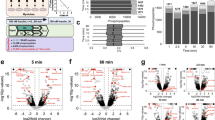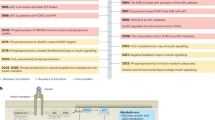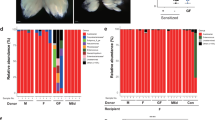Abstract
Amino-acid starvation leads to an inhibition of cellular proliferation and the induction of programmed cell death (PCD) in the Drosophila ovary. Disruption of insulin signaling has been shown to inhibit the progression of oogenesis, but it is unclear whether this phenotype mimics starvation. Here, we investigate whether the insulin-mediated phosphoinositide kinase-3 pathway regulates PCD in mid oogenesis. We reasoned that under well-fed conditions, disruption of positive components of the insulin signaling pathway within the germline would mimic starvation and produce degenerating egg chambers. Surprisingly, mutants did not mimic starvation but instead produced many abnormal egg chambers in which the somatic follicle cells disappeared and the germline persisted. These abnormal egg chambers did not show an induction of caspases and lysosomes like that observed in wild-type (WT) degenerating egg chambers. Egg chambers from insulin signaling mutants were resistant to starvation-induced PCD, indicating that a complete block in insulin-signaling prevents the proper response to starvation. However, target of rapamycin (Tor) mutants did show a phenotype that mimicked WT starvation-induced PCD, indicating an insulin independent regulation of PCD via Tor signaling. These results suggest that inhibition of the insulin signaling pathway is not sufficient to regulate starvation-induced PCD in mid oogenesis. Furthermore, starvation-induced PCD is regulated by Tor signaling converging with the canonical insulin signaling pathway.
Similar content being viewed by others
Log in or create a free account to read this content
Gain free access to this article, as well as selected content from this journal and more on nature.com
or
Abbreviations
- Dcp-1:
-
death caspase-1
- DIAP1:
-
Drosophila inhibitor of apoptosis protein 1
- Dronc:
-
Drosophila nedd-2 like caspase
- FC:
-
follicle cell
- GLC:
-
germline clone
- Hid:
-
head involution defective
- InR:
-
insulin receptor
- LT:
-
LysoTracker
- NC:
-
nurse cell
- PCD:
-
programmed cell death
- PI3K:
-
phosphoinositide kinase-3
- Pwop:
-
peas without pods
- Rpr:
-
Reaper
- Skl:
-
Sickle
- S6k :
-
Ribosomal protein S6 kinase
- Strica:
-
Serine threonine rich caspase
- tGPH:
-
tubulin-Green Fluorescent Protein Plextrin Homology
- Tor :
-
target of rapamycin
- WT:
-
wild-type
References
Yoshimura Y, Ando M, Nagamatsu S, Iwashita M, Adachi T, Sueoka K et al. Effects of insulin-like growth factor-I on follicle growth, oocyte maturation, and ovarian steroidogenesis and plasminogen activator activity in the rabbit. Biol Reprod 1996; 55: 152–160.
Acevedo N, Ding J, Smith GD . Insulin signaling in mouse oocytes. Biol Reprod 2007; 77: 872–879.
Tissenbaum HA, Ruvkun G . An insulin-like signaling pathway affects both longevity and reproduction in Caenorhabditis elegans. Genetics 1998; 148: 703–717.
Lin K, Hsin H, Libina N, Kenyon C . Regulation of the Caenorhabditis elegans longevity protein DAF-16 by insulin/IGF-1 and germline signaling. Nat Genet 2001; 28: 139–145.
Pritchett TL, Tanner EA, McCall K . Cracking open cell death in the Drosophila ovary. Apoptosis 2009; 14: 969–979.
Sang JH, King RC . Nutritional requirements of axenically cultured Drosophila melanogaster adults. J Exp Biol 2010; 38: 793–809.
Drummond-Barbosa D, Spradling AC . Stem cells and their progeny respond to nutritional changes during Drosophila oogenesis. Dev Biol 2001; 231: 265–278.
Buszczak M, Cooley L . Eggs to die for: cell death during Drosophila oogenesis. Cell Death Differ 2000; 7: 1071–1074.
Peterson JS, Bass BP, Jue D, Rodriguez A, Abrams JM, McCall K . Noncanonical cell death pathways act during Drosophila oogenesis. Genesis 2007; 45: 396–404.
Tanner EA, Blute TA, Brachmann CB, McCall K . Bcl-2 proteins and autophagy regulate mitochondrial dynamics during programmed cell death in the Drosophila ovary. Development 2011; 138: 327–338.
Berry DL, Baehrecke EH . Autophagy functions in programmed cell death. Autophagy 2008; 4: 359–360.
Denton D, Shravage B, Simin R, Mills K, Berry DL, Baehrecke EH et al. Autophagy, not apoptosis, is essential for midgut cell death in Drosophila. Curr Biol 2009; 19: 1741–1746.
LaFever L, Feoktistov A, Hsu HJ, Drummond-Barbosa D . Specific roles of Target of rapamycin in the control of stem cells and their progeny in the Drosophila ovary. Development 2010; 137: 2117–2126.
Zhang Y, Billington Jr CJ, Pan D, Neufeld TP . Drosophila target of rapamycin kinase functions as a multimer. Genetics 2006; 172: 355–362.
Barth JM, Szabad J, Hafen E, Kohler K . Autophagy in Drosophila ovaries is induced by starvation and is required for oogenesis. Cell Death Differ 2011; 18: 915–924.
Bohni R, Riesgo-Escovar J, Oldham S, Brogiolo W, Stocker H, Andruss BF et al. Autonomous control of cell and organ size by CHICO, a Drosophila homolog of vertebrate IRS1-4. Cell 1999; 97: 865–875.
Brogiolo W, Stocker H, Ikeya T, Rintelen F, Fernandez R, Hafen E . An evolutionarily conserved function of the Drosophila insulin receptor and insulin-like peptides in growth control. Curr Biol 2001; 11: 213–221.
Zhang H, Stallock JP, Ng JC, Reinhard C, Neufeld TP . Regulation of cellular growth by the Drosophila target of rapamycin dTOR. Genes Dev 2000; 14: 2712–2724.
Oldham S, Montagne J, Radimerski T, Thomas G, Hafen E . Genetic and biochemical characterization of dTOR, the Drosophila homolog of the target of rapamycin. Genes Dev 2000; 14: 2689–2694.
Richard DS, Rybczynski R, Wilson TG, Wang Y, Wayne ML, Zhou Y et al. Insulin signaling is necessary for vitellogenesis in Drosophila melanogaster independent of the roles of juvenile hormone and ecdysteroids: female sterility of the chico1 insulin signaling mutation is autonomous to the ovary. J Insect Physiol 2005; 51: 455–464.
Fan Y, Bergmann A . The cleaved-Caspase-3 antibody is a marker of Caspase-9-like DRONC activity in Drosophila. Cell Death Differ 2010; 17: 534–539.
Rusten TE, Lindmo K, Juhasz G, Sass M, Seglen PO, Brech A et al. Programmed autophagy in the Drosophila fat body is induced by ecdysone through regulation of the PI3K pathway. Dev Cell 2004; 7: 179–192.
Nezis IP, Shravage BV, Sagona AP, Lamark T, Bjorkoy G, Johansen T et al. Autophagic degradation of dBruce controls DNA fragmentation in nurse cells during late Drosophila melanogaster oogenesis. J Cell Biol 2010; 190: 523–531.
Rameh LE, Cantley LC . The role of phosphoinositide 3-kinase lipid products in cell function. J Biol Chem 1999; 274: 8347–8350.
Britton JS, Lockwood WK, Li L, Cohen SM, Edgar BA . Drosophila′s insulin/PI3-kinase pathway coordinates cellular metabolism with nutritional conditions. Dev Cell 2002; 2: 239–249.
Thomson TC, Johnson J . Inducible somatic oocyte destruction in response to rapamycin requires wild-type regulation of follicle cell epithelial polarity. Cell Death Differ 2010; 17: 1717–1727.
Sancak Y, Peterson TR, Shaul YD, Lindquist RA, Thoreen CC, Bar-Peled L et al. The Rag GTPases bind raptor and mediate amino acid signaling to mTORC1. Science 2008; 320: 1496–1501.
Findlay GM, Yan L, Procter J, Mieulet V, Lamb RF . A MAP4 kinase related to Ste20 is a nutrient-sensitive regulator of mTOR signalling. Biochem J 2007; 403: 13–20.
Kim E, Goraksha-Hicks P, Li L, Neufeld TP, Guan KL . Regulation of TORC1 by Rag GTPases in nutrient response. Nat Cell Biol 2008; 10: 935–945.
Bryk B, Hahn K, Cohen SM, Teleman AA . MAP4K3 regulates body size and metabolism in Drosophila. Dev Biol 2010; 344: 150–157.
Soulard A, Cohen A, Hall MN . TOR signaling in invertebrates. Curr Opin Cell Biol 2009; 21: 825–836.
Cybulski N, Hall MN . TOR complex 2: a signaling pathway of its own. Trends Biochem Sci 2009; 34: 620–627.
Lee G, Chung J . Discrete functions of rictor and raptor in cell growth regulation in Drosophila. Biochem Biophys Res Commun 2007; 357: 1154–1159.
Werz C, Kohler K, Hafen E, Stocker H . The Drosophila SH2B family adaptor Lnk acts in parallel to chico in the insulin signaling pathway. PLoS Genet 2009; 5: e1000596.
Bass BP, Tanner EA, Mateos San Martin D, Blute T, Kinser RD, Dolph PJ et al. Cell-autonomous requirement for DNaseII in nonapoptotic cell death. Cell Death Differ 2009; 16: 1362–1371.
Golstein P, Kroemer G . Cell death by necrosis: towards a molecular definition. Trends Biochem Sci 2007; 32: 37–43.
Rodrigues P, Limback D, McGinnis LK, Plancha CE, Albertini DF . Multiple mechanisms of germ cell loss in the perinatal mouse ovary. Reproduction 2009; 137: 709–720.
Reddy P, Adhikari D, Zheng W, Liang S, Hamalainen T, Tohonen V et al. PDK1 signaling in oocytes controls reproductive aging and lifespan by manipulating the survival of primordial follicles. Hum Mol Genet 2009; 18: 2813–2824.
Lobascio AM, Klinger FG, Scaldaferri ML, Farini D, De Felici M . Analysis of programmed cell death in mouse fetal oocytes. Reproduction 2007; 134: 241–252.
Yaba A, Bianchi V, Borini A, Johnson J . A putative mitotic checkpoint dependent on mTOR function controls cell proliferation and survival in ovarian granulosa cells. Reprod Sci 2008; 15: 128–138.
Montagne J, Stewart MJ, Stocker H, Hafen E, Kozma SC, Thomas G . Drosophila S6 kinase: a regulator of cell size. Science 1999; 285: 2126–2129.
Yoo SJ, Huh JR, Muro I, Yu H, Wang L, Wang SL et al. Hid, Rpr and Grim negatively regulate DIAP1 levels through distinct mechanisms. Nat Cell Biol 2002; 4: 416–424.
Kugler JM, Lem C, Lasko P . Reduced cul-5 activity causes aberrant follicular morphogenesis and germ cell loss in Drosophila oogenesis. PLoS One 2010; 5: e9048.
McCall K, Peterson JS, Pritchett TL . Detection of cell death in Drosophila. Methods Mol Biol 2009; 559: 343–356.
Acknowledgements
We thank Thomas Neufeld, Daniela Drummond-Barbosa, Armen Manoukian, Bruce Edgar, and the Bloomington Stock Center for flies. We thank Bruce Hay, Ioannis Nezis, and the Developmental Studies Hybridoma Bank for antibodies. We thank members of the lab, Caryn Navarro, Rob Hausman, John Celenza, and Horacio Frydman for helpful suggestions. We apologize to authors whose work we could not cite due to space limitations. This work was supported by NIH R01 GM060574 to KM and the NSF Northeast Alliance for Graduate Education and the Professoriate HRD-0450339 (TP).
Author information
Authors and Affiliations
Corresponding author
Ethics declarations
Competing interests
The authors declare no conflict of interest.
Additional information
Edited by E Baehrecke
Supplementary Information accompanies the paper on Cell Death and Differentiation website
Rights and permissions
About this article
Cite this article
Pritchett, T., McCall, K. Role of the insulin/Tor signaling network in starvation-induced programmed cell death in Drosophila oogenesis. Cell Death Differ 19, 1069–1079 (2012). https://doi.org/10.1038/cdd.2011.200
Received:
Revised:
Accepted:
Published:
Issue date:
DOI: https://doi.org/10.1038/cdd.2011.200
Keywords
This article is cited by
-
The ovary and its genes—developmental processes underlying the establishment and function of a highly divergent reproductive system in the female castes of the honey bee, Apis mellifera
Apidologie (2018)
-
The TORC1 inhibitors Nprl2 and Nprl3 mediate an adaptive response to amino-acid starvation in Drosophila
Cell Death & Differentiation (2014)



